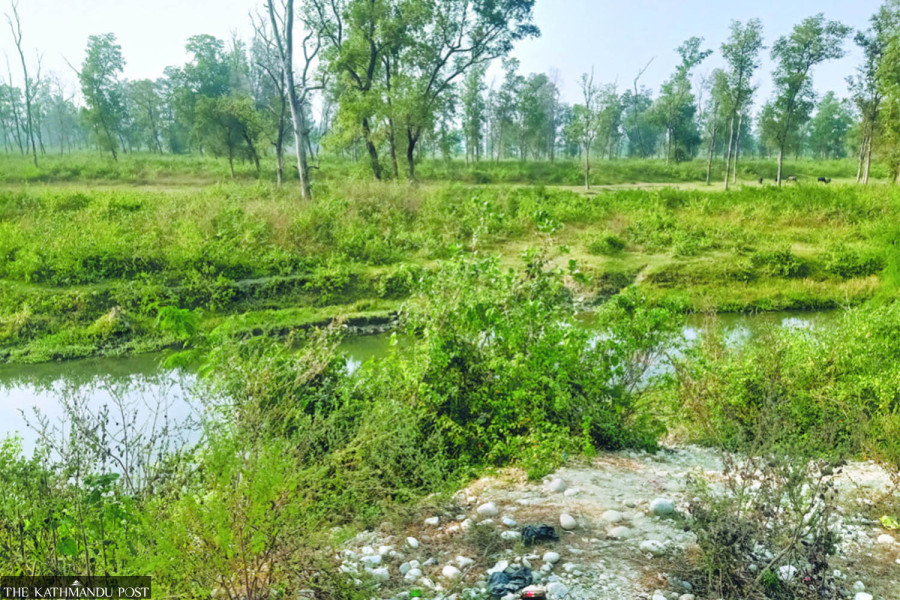Money
Dodhara Chandani dry port construction stalls again over tree felling issues
Nepal Intermodal Transport Development Board proposes cash compensation to government after failing to find land for planting compensatory trees.
Post Report
The much-delayed Dodhara Chandani dry port and check post project in farwestern Nepal took a step forward in September after the Sudhurpaschim provincial cabinet approved using forest land to build the facility.
The cabinet has allowed the Nepal Intermodal Transport Development Board to use 43 hectares of Mayapuri community forest in the buffer zone of Suklaphanta National Park, clearing the project's last major hurdle. Nearly 1,700 trees have to be felled to make way for the project.
Now, the project has stalled again because the board planned to pay a compensatory amount instead of planting trees on a separate land, as required by the law.
According to the Forest Clearance Guidelines, ten trees must be planted for every one felled for development projects.
“As we did not find suitable land to plant compensatory trees. We are making a cash payment instead and have written to the forest ministry accordingly,” said Ashish Gajurel, executive director of Nepal Intermodal Transport Development Board.
“We, however, have not heard back from the ministry.”
The board sent its request to the ministry through the Department of National Parks and Wildlife Conservation before the Dashain festival (early October).
He said that once the ministry gives a go-ahead, the project would deposit Rs150 million, the estimated compensatory amount. “Any further delay by the government will also push back the construction timeline,” said Gajurel.
The Rs15 billion project is located in Dodhara Chandani Municipality, Kanchanpur district, and is listed by the government as a national priority project.
In 2023, the government approved the project's environmental impact assessment (EIA) report.
Once completed, the dry port is expected to boost the Nepal-India trade and help drive industrial development in the western region.
The Dodhara Chandani dry port will be the first business gateway to India from Nepal's farwest. The site is 245 km from India’s capital, New Delhi, and 1,200 km from Gujarat, which is among India’s fastest-growing states.
Officials said the dry port will facilitate trade with other Indian states like Rajasthan, Uttarakhand, Punjab, and Haryana. It will also provide Nepal access to India’s largest seaport, Jawaharlal Nehru Port in Mumbai, boost Nepal's foreign trade, and reduce costs.
Nepali officials say transporting goods to Nepal through these routes will result in substantial savings.
Most of Nepal's trade infrastructure is concentrated in the east, connecting to Kolkata port. Officials say constructing a dry port in Sudurpaschim Province may open up access to more Indian ports in the future.
The project is also expected to reduce transportation costs and reduce the time required to import goods from India.
Dodhara Chandani inland container depot will feature administrative buildings, customs offices, banks, quarantine facilities, staff quarters, warehouses, and parking spaces.
As per the master plan, the depot will eventually accommodate 3,000 20-foot freight trucks, although it will provide space for 300 trucks in the first phase.
The import warehouse will be 7,000 square metres, and the export warehouse will be 2,520 square metres. The railway warehouse will be 17,500 square metres, and the container stacking yard, a large open space for container movement, will be 10,000 square metres.
In the project's second phase, 126 hectares will be developed for additional warehouses and parking areas.
Work has already started on a Rs3.2 billion access road on the Indian side connecting Dodhara Chandani. The Indian government is building the access road.
Gajurel said that India has been preparing tender documents to start the construction of the dry port, which it is building on a grant.
“Once we clear trees from the project sites, India will formally begin construction.”
“As per discussions with Indian authorities, they plan to issue a tender within a month. Construction may begin within 3-4 months after a contractor is appointed,” said Gajurel.
The deadline for the completion of the dry port is three years.
A decade and a half ago, the World Bank conducted a feasibility study for the proposed dry port at Kanjabhoj in Dodhara Chandani Municipality, and the Nepal Intermodal Transport Development Board prepared another report in 2016.
Three years ago, the government decided to construct the facility in ward 1 of Chandani Municipality. However, the project was relocated following protests by residents in Kanjabjoj, which is in ward 8, which was initially planned for the project.
Last year, during then prime minister Pushpa Kamal Dahal's visit to India, the Indian government agreed to build the facility.
A four-lane bridge over the Mahakali River has been built, and an 8-km access road has been built on the Nepal side between Gaddachauki and the Malariya River in ward 1 of Dodhara Chandani.
Meanwhile, according to Gajurel, the construction of the Rasuwa dry port at Nepal-China border in the north will be completed by mid-June next year. Gajurel said the construction of the Bhairahawa dry port is also expected to be completed by June of next year.




 4.12°C Kathmandu
4.12°C Kathmandu














